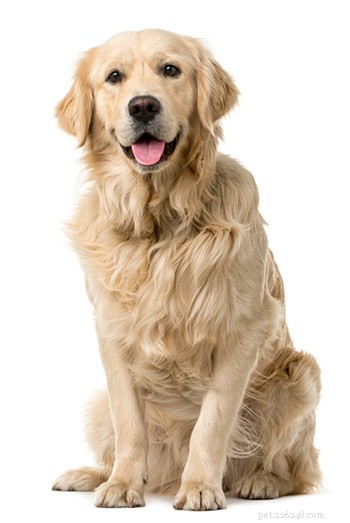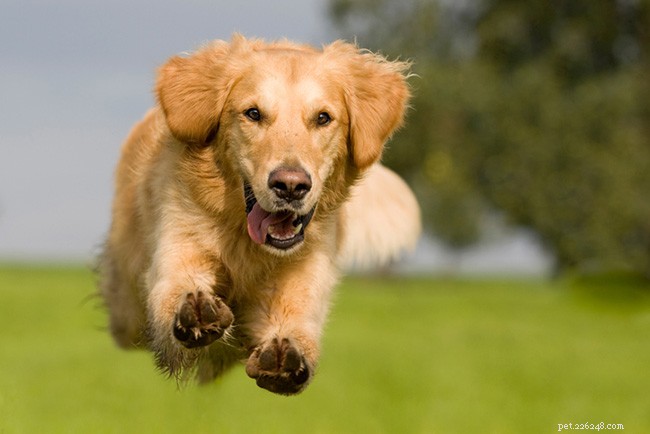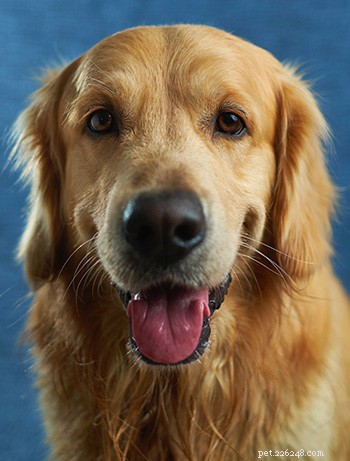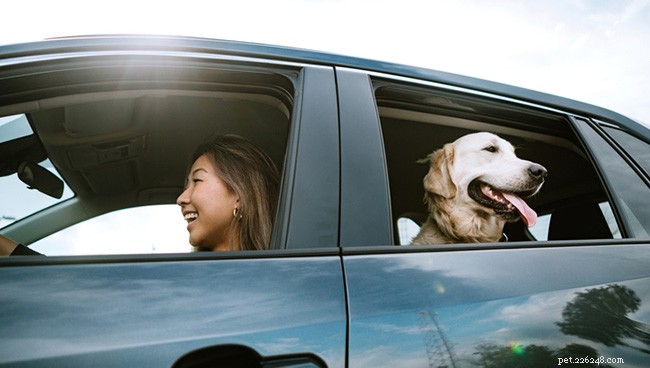Golden Retrievers staan bekend als intelligente honden met een vriendelijk temperament en blijvende loyaliteit en behoren tot de meest populaire hondenrassen in Amerika. Deze geliefde honden hebben prachtige goudkleurige vachten en zijn geweldige gezinshonden omdat ze betrouwbaar, van nature atletisch zijn en mensen willen plezieren.
Golden Retrievers zijn middelgrote tot grote honden, maar zoals bij de meeste honden, zijn mannetjes meestal groter dan vrouwtjes. Het duurt ongeveer een jaar voordat een Golden Retriever zijn volledige lengte heeft bereikt en ongeveer twee jaar om een volwassen gewicht te bereiken.
Zoals je in deze grafiek kunt zien, kunnen er veel verschillen in grootte zijn tussen Goldens als ze groeien en zich ontwikkelen tot volwassenen.
| Leeftijd | 3 maanden | 6 maanden | 1 jaar | 2 jaar |
|---|---|---|---|---|
| Mannelijke Golden Retriever | 16-43 lbs. | 29-72 lbs. | 65-77 lbs. | 65-80 lbs. |
| Vrouwelijke Golden Retriever | 16-33 lbs. | 27-61 lbs. | 55-90 lbs. | 55-90 lbs. |
Als ze volgroeid zijn, zijn mannelijke Golden Retrievers ongeveer 23 tot 24 centimeter lang en vrouwtjes tussen 21,5 en 22,5 centimeter lang. De algehele groei kan worden beïnvloed door genetica, voeding en op welke leeftijd de hond wordt gesteriliseerd of gecastreerd.
Als je de persoonlijkheid van een Golden Retriever leert kennen, kun je dit verwachten op basis van zijn of haar raskenmerken.
| Raskenmerk | Niveau (Hoog, Gemiddeld, Laag) |
|---|---|
| Aanhankelijk met mensen | Hoog |
| Goed met kinderen | Hoog |
| Goed met huisdieren | Hoog |
| Behoefte aan oefening | Hoog |
| Energieniveau | Hoog |
| Intelligentieniveau | Hoog |
| Kan opgeleid worden | Hoog |
| Hoeveelheid blaffen | Gemiddeld |
| Hoeveelheid verlies | Hoog |
Naast deze gevestigde kenmerken zijn Golden Retrievers ook zeer bekwame werkhonden die uitstekend kunnen volgen, jagen en snuffelen. This makes them prime candidates for positions as therapy dogs and law enforcement dogs. Because of their outstanding agility, Golden Retrievers often perform well at dog competitions. They are also generally obedient dogs with positive attitudes, which means that they are easy to train.
However, Golden Retrievers are not necessarily the most adaptable dogs because they are sensitive, don’t like being left alone, and tolerate hot and cold weather only moderately well.
Dudley Marjoribanks, also known as Lord Tweedmouth, developed the Golden Retriever breed in the Scottish Highlands in the mid-to-late 1800s. He was a hunter who desired a hunting companion dog with a great nose and was attentive and loyal as a family dog at home. Marjoribanks kept detailed records of his breeding pursuits and tried to breed various types of animals. To achieve the Golden Retriever, he crossed a Yellow Retriever with a Tweed Water Spaniel and also had an Irish Setter and Bloodhound in the mix. With a precise blend of dogs in the breeding plan, the Golden Retriever breed received an improved sense of smell and a more moderate size.
The breed first attracted hunters’ attention but was later embraced for its versatile showmanship and exceptional companionship. In 1908, a Golden Retriever first entered a British dog show, and the breed soon made its way into Canada and the U.S. Golden Retrievers were recognized as a breed by the Kennel Club in England in 1911 and by the American Kennel Club in 1932.
There were once rumors that Golden Retrievers were descendants of Russian circus dogs, but this was disproven in the 1950s when one of Marjoribanks’ descendants provided access to the breeder’s handwritten records. In the U.S., the popularity of Golden Retrievers picked up in the 1970s and 1980s. The dogs have been major characters in film and television, with starring roles in the TV show “Full House” and the movie “Air Bud.” The American Kennel Club currently ranks this breed’s popularity at #3 out of 196.
Golden Retrievers are active, coordinated, eager, self-confident, and alert. With a symmetrically-aligned body, these dogs are hunting dogs by nature and have a hard-working and powerful appearance.
Purebred Golden Retrievers exhibit the following physical characteristics, which define the breed standard for this type of dog.
 Head:
Head:
Neck, Topline, Body:
Forequarters:
Hindquarters:
Coat:
Color:
Gait :

Golden Retrievers are a real joy to care for because of their fun, positive, and outgoing personalities. Here are some tips for caring for a Golden Retriever.
Best Living Environments:
Type of Exercise:
Mental Enrichment:
Training Strategies:
Grooming Tips:

Even with their healthy appearances and high activity levels, Golden Retrievers are not immune to many health problems that affect dogs. In fact, Goldens are prone to many health problems, but you can help control these potential issues with loving care and being prepared with a pet insurance policy.
These are some of the most common health issues that arise with Golden Retrievers:
The average life expectancy for a Golden Retriever is 10 to 12 years. However, taking your Golden to a vet for an annual checkup, keeping up with routine at-home care, and maintaining a healthy diet and exercise can extend your pet’s life for several more years. These are also ways to extend your Golden’s mobility to ensure a happier life and avoid surgery that could leave a Golden less mobile and more prone to obesity.
Good nutrition is essential in the care of a Golden Retriever because these active dogs need high-quality food to sustain their energy levels. Goldens tend to become overweight when given too many treats or table scraps, so provide these foods sparingly and monitor the dog’s weight regularly. In fact, you can skip the table scraps entirely because they tend to be high in fat and calories.
Adult Golden Retrievers typically eat three cups of food per day, which comes out to an average daily cost of $2 to $2.25 and an average monthly cost of $60 to $67.50 for food. A Golden’s meals are usually split into two meals per day – one in the morning and one in the evening.
Recommended types of dog food for Golden Retrievers include Wellness Complete Health Large Breed Adult, Taste of the Wild Southwest Canyon, Blue Buffalo Wilderness Grain-Free Chicken, and Earthborn Holistic Grain Free Large Breed. It is a good idea to keep filler ingredients out of your Golden’s diet, such as corn, soy, and rice because these contribute to weight gain without much nutrition. As your Golden gets older and less active, you will need to reduce the amount of daily food provided to prevent overeating and obesity.

The Golden Retriever Club of America provides resources about this breed of dog on its website and allows you to search for Goldens and learn about responsible breeders here too. The American Kennel Club offers an online marketplace that provides search results for Golden Retriever puppy litters in various places across the country. Reputable Golden Retriever breeders include Bowden’s Goldens in Oxford, Maine, Golden Sunrise Retrievers in Toledo, Ohio; and Sweet Gold Farm in Enumclaw, Washington.
There are also Golden Retriever rescue groups available and listed by region on the Golden Retriever Club of America National Rescue Committee’s website. Adopt a Pet, North America’s largest nonprofit pet adoption website, and PetFinder also offer listings of adoptable Goldens. You can set an alert to be notified when a Golden Retriever becomes available for adoption near you.
Golden Retrievers are members of the Sporting Group of dog breeds, which includes dogs that are naturally active, likable, skilled at hunting, and that make good companions. Other Sporting Group dogs include the American Water Spaniel, Cocker Spaniel, English Setter, Labrador Retriever, and Weimaraner.
People interested in Golden Retrievers may also like other breeds that make good family dogs, are highly intelligent, and good around kids. Other breeds that fit into these categories include the Alaskan Malamute, Beagle, American Staffordshire Terrier, and Boston Terrier.
Golden Retrievers are beloved family members and deserve the level of care and attention you would give any loved one. Since many of the health conditions that Golden Retrievers experience are genetic, it is wise to get pet insurance for Goldens of any age – from the youngest puppies to senior dogs.
Healthy Paws insurance plans cover accidents, illnesses, cancer, emergency care, genetic conditions, and alternative care so that your Golden can live the healthiest life possible. With our easy claims process and top-rated customer service team, you can take your Golden Retriever to any licensed veterinarian you trust when your pup isn’t feeling well and take preventative measures for better overall health.